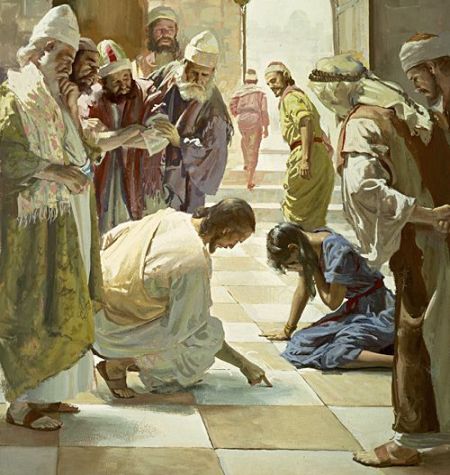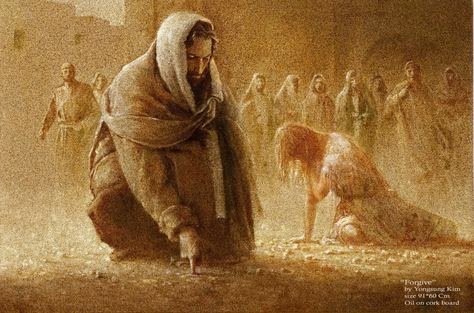GOVERNMENT 26 - Jesus and the Adulteress
With thoughts from Landa L. Cope
The wider context
- Only John has a description of this encounter of Jesus with a woman caught in adultery, though other examples of conflicts with the Pharisees and scribes abound in all four gospels.
- When in Jesus’ life does this happen? John writes his gospel arranging it around seven signs Jesus shows at various Jewish feasts, so this event in not so easily dated.
- According to John’s sequence of events right after this scene with the woman caught in adultery Jesus will foretell his own death (Jhn 8:21-30), exacerbate the conflict with the Pharisees by healing a man born blind (Jhn 9), all in Jerusalem. Then he will leave Jerusalem, and come back again to raise Lazarus’ (Jhn 11), enter Jerusalem (Jhn 12:12-19) and spent some last time with the disciple before his death (Jhn 13-19).
- So It seems that John dates the encounter with the adulteress to the later part of Jesus ministry, but not to the final week of his life.
Immediate context of the story
- According to John’s sequence of events, Jesus has long been in the public eye and his brothers have tried to manage his appearance in Jerusalem (Jhn 7:1-5). Jesus goes a bit later, participating in the festival of booths (Jhn 7:1), one of the three yearly festivals that required Jews to come to Jerusalem. Jerusalem is therefore full of Jews from various corners of the country and even from abroad.
- Jesus publicly claims to be the source of live giving water (Jhn 7:37) and also that those who drink from him will become wells of living water themselves (Jhn 7:38). Messiah hopes are running wild, doubts also (Jhn 7:40-44). The Pharisees have already sent temple police to arrest him (Jhn 7:32), but the officers were so awed by Jesus that didn’t lay hands on him “Never has anyone spoken like this!” (Jhn 7:46).
- The festival lasted a minimum of 8 days, Jesus uses the time to teach:
The setting John 8:1-4
“Early in the morning he came again to the temple. All the people came to him and he sat down and began to teach them. 3 The scribes and the Pharisees brought a woman who had been caught in adultery; and making her stand before all of them, 4 they said to him…”
- Jesus is teaching willing listeners early morning in the temple premises. These are likely those with high hopes, maybe also others who are trying to find out who he really is. The scene is very public.
- Then it unfolds: A woman is dragged in by the scribes and Pharisees and made to stand before Jesus. They accuse her of adultery.
- What would a normal handling of an adultery case have looked like? We don’t know for sure.
The case John 8:4-6
“They said to him, “Teacher, this woman was caught in the very act of committing adultery. 5 Now in the law Moses commanded us to stone such women. Now what do you say?” 6 They said this to test him, so that they might have some charge to bring against him.”
- It is theoretically possible that they just happened to stumbled across this adultery unwittingly, and that the idea to bring this before Jesus was a ‘happy after thought’.
- But more likely, they come up with this, because they want “to test him”. Actually, most of them are already convinced that Jesus is a fraud, worse that he is a a deceiver (Jhn 7:32, 45-52) and that he must be silenced. So create a situation to find out whether here in Jerusalem in their very presence he dares to overstep the law (as they have long have had reports he did elsewhere).
- If this is a set-up, then to set this up would have involved a lot of stepping over one’s conscience: This would mean they assembled intentionally in large enough numbers. They would have to find an adultery that they could catch at a convenient hour (which means that it had been going on regularly, and they didn’t interfere, didn’t warn, didn’t counsel, didn’t prevent). Yet with all that to catch an adultery “in the very act” as they claim would have mean stalking, waiting, observing. Not a nice business.

- Another issue is that though an adultery is by definition an act committed by two people, they let the man go and hold on to the woman. In a worst case scenario, the man acted knowing about their intention to discover them. But even if not, the Law of Moses clearly stipulates that both man and woman are equally guilty and liable to punishment (Deu 22:22). To apply a law selectively is a form of injustice already.
But what exactly is the trap they set up for Jesus with this?
- The trap is that Jesus, by claiming to be the Father’s representative (which he did multiple times in Jhn 5-6), he now cannot go against God’s law. And the law says to stone adulterers. So if he doesn’t push for a stoning, he contradicts his claim of being a representative of his Father in heaven, and with that much of his earlier teaching. If he doesn’t defend the law, his righteousness and authority is in question.
- Another issue: Jesus had come to popularity at least partially by the tremendous grace and freeing acceptance that he had shown to all, especially to those on the fringes of society. By forcing Jesus’ hand to push though a stoning of the woman, the scribes and Pharisees would have accomplished at least their goal of breaking Jesus’ popularity, of putting his grace into question, of forcing him to negate his earlier behavior.
- Yet to force him to push through with a stoning is a trap in one more way: According to Roman rule, death penalties can only be given by Roman courts and meted out by Roman officials. The Jewish council was given the right to judge minor cases, but it was not given the right to pass death sentences, far less to implement them. This can be seen in Jesus’ own trial, where they cannot implement the death sentence without Pilate’s consent.
- But now: according to Roman law adultery is not illegal, it is not a crime punishable by death under Roman law. So by stoning the adulteress Jesus would become guilty of a crime under Roman law, guilty for an unauthorized killing, a full-on murder. Murder on the other hand was a punishable offense under Roman law. If Jesus pushes ahead the stoning of the woman, he then becomes guilty of murder under the Roman law, and they can accuse him for that!
- The falseness of the position they put Jesus in also lies in the fact that the Jews have not meted out death penalties for adultery for centuries. Yes, it was God’s law originally, but they have long departed from that. God allows them to change the law if they so desire, as can be seen from the transition of Israel from an elective and representative government to a monarchy in 1 Sam 8. God warns them and counsels them to not do that, but when they persist, he lets them do it.
- Or another example: When David commits adultery with Bathsheba (and also murder of her husband Uriah), he does not execute himself for either as should have been done if the original Law of God was still in place.
Another example is Joseph, upon finding out that Mary is pregnant, he doesn’t push for a stoning, as is stipulated for the adultery of an engaged person (see Deu 22:23-24), rather he plans to dissolve the engagement without further ado and is called “righteous” for that in Mth 1:19.
Jesus’ handling of the case John 8:6-11
“6 Jesus bent down and wrote with his finger on the ground.”

Why does Jesus not respond immediately? Why does he bend down? Why does he not face them? And what does he write?
- I think by his actions Jesus breaks the heat of the moment, the anger, indignation, the supposed logic of what needs to be done. He ensures that conviction by the Holy Spirit has time to set in, that conscience may speak.
- Most likely Jesus also uses this time also for intense prayer, for himself to know how to respond by relying on the Holy Spirit and to intercede for them to be convicted.
- What did Jesus write? Possibly it wasn’t so much for others to read, more to give time. Or possibly it was very much Jesus message: Later ancient manuscripts have additional words here: “and wrote the sins of each of them”. So many understand this passage in this way; Jesus writes with his finger the law, other laws, laws which they break and for which they do not accuse or prosecute themselves.
“7 When they kept on questioning him, he straightener up and said to them, “Let anyone among you who is without sin be the first to throw a stone at her.” 8 And once again he bent down and wrote on the ground. 9 When they heard it, they went away, one by one, beginning with the elders … “
- They will not let go of their smart scheme, the trap is too well set. They are convinced they can catch him and are committed to do so.
- Seeing that, Jesus answers “Let anyone among you who is without sin be the first to throw a stone at her.” With a simple, humble and profound sentence Jesus breaks the trap:
- He challenges them to search their hearts. He pounds their self-righteousness. As he had challenged earlier: “You have heard that it was said, “you shall not commit adultery.” But I say to you that everyone who looks at a woman with lust has already committed adultery with her in his heart” (Mth 5:27-28). Surely they are not so above things! … or similar things.
- He challenges their self-righteousness and hard hearts, who let this adultery happen, who even observed and yet not prevented it, showing that they didn’t work for righteousness at all.
- He challenges their selective application of the law, demanding stoning of an adulterer, but what about all the other laws in Deuteronomy that are not kept and that nobody prosecutes anybody for?
He challenges their uneven application of the law: Not on the man, but on the woman. Not on them, but on this woman. - He also cuts through the tangle with the Roman law. He basically says: If you feel so strongly about it, you become an offender under Roman law, you become guilty of a murder! And of course, if they did that, they would be no longer without sin, so they would have no right to judge in the first place. Another nice tangle.
- He bows down to write in the sand again. This is not a debate to be won, not a triumph to be achieved. Jesus’ goal is not a public shaming, his goal is conviction.
- Jesus’ words cut deep, laying bare their wrong motivations and dismantling their narrow interpretations. Finally some conviction comes through, they leave maybe still in anger, or maybe in shame.
“9 and Jesus was left alone with the woman standing before him. 10 Jesus straightened up and said to her, “Woman, where are they? Has no one condemned you?” 11 She said, “No one, sir.” And Jesus said, “Neither do I condemn you. Go your way, and from now on do not sin again.”
- Jesus starts speaking to the woman, not as a judge, but as somebody who cares and who is truly concerned about her within this. Jesus – unlike the others – would have the moral authority to condemn because of his righteous life, but that is not what he came for. His righteousness will not condemn her, it will be made available to her by his death on the cross.
- Yet he is also concerned with her life: “do not sin again”. Adultery is sin, it cheats everyone, it does destroy lives. Jesus does not only free from the penalty of sin, but from the power of sin. He wants her free from the penalty and the power of adultery, free to live a godly life. Grace and holiness.
